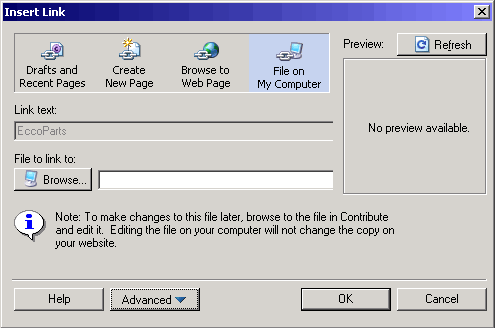Inserting a Microsoft Word Document
Inserting a Microsoft Word Document
|
 |
|
Figure 8. Inserting a Microsoft Word document into your web page.
|
|
Figure 8 shows how your Word file is inserted into your page in Contribute, preserving the Microsoft Word document’s text styles, formatting, and table formatting. You can also link your pages to larger Microsoft Word files, or the original Word files. This reduces your page size and a user browsing the page can click a link and open the page in Word, which can be handy. You can also drag and drop Word files from the desktop to the page instead of using the buttons in Contribute. Contribute lets you choose how to link or import the file.
You need to edit one more page. Now that you have a detail page for Ecco Auto Parts, you need to link that new page to the Suppliers page which you haven’t looked at yet.
|
 |
|
Figure 9. The Insert Link dialog box.
|
|
You can select several objects to link to, but you should link to the file that you created in the last step. Therefore, select the option “File on My Computer” and click the Browse… button to navigate to the EccoSupplierDatasheet.htm file in the suppliersecco folder in your TrioNet site. If you click the Preview option, a preview of the page will show in the preview box. Click OK.
|


Comments